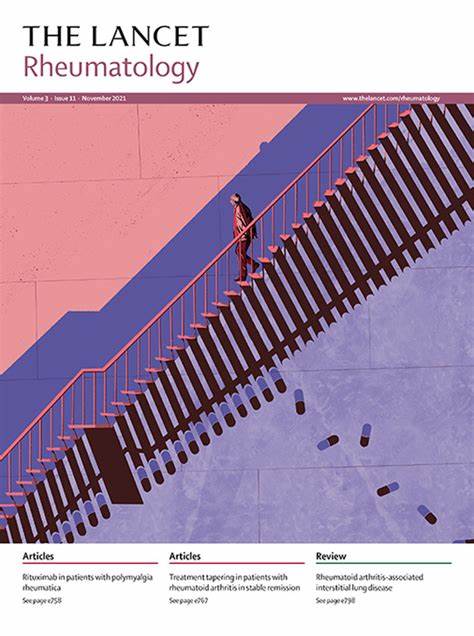Patient-initiated follow-up supported by asynchronous telemedicine versus usual care in spondyloarthritis (TeleSpA-study): a randomised controlled trial of clinical and cost-effectiveness
IF 15
1区 医学
Q1 RHEUMATOLOGY
引用次数: 0
Abstract
Background
With rising health-care expenditures and workforce shortages, sustainable alternatives to traditional outpatient follow-up strategies are required to optimise care efficiency. We aimed to investigate the cost-effectiveness and clinical effectiveness of patient-initiated follow-up (PIFU) supported by asynchronous telemedicine for patients with spondyloarthritis compared with usual care in daily practice.
Methods
TeleSpA was a multicentre, pragmatic, open-label, randomised controlled trial. Patients with spondyloarthritis and stable disease were randomly assigned (1:1) to either the PIFU and asynchronous telemedicine group or usual care group. All patients received a scheduled outpatient visit at baseline and after 1 year. Patients were monitored remotely at 6 months (PIFU and asynchronous telemedicine) or at the discretion of the treating rheumatologist (usual care). The primary outcome was the number of rheumatology visits within a 1-year period. A trial-based 1-year health-economic evaluation from a Dutch health-care perspective (only including health-care costs) and societal perspective (also including travel costs and work productivity losses), per the Dutch guidelines was used to estimate cost-effectiveness. The safety analysis was done in the intention-to-treat population and was based on spontaneous reports of adverse events and serious adverse events or as observed by the research team. The primary analysis was in the intention-to-treat population. Individuals with relevant lived experience were involved in the study design. This trial was registered with the Dutch National Trial Register (NL71041.068.19) and ClinicalTrials.gov (NCT04673825) and is completed.
Findings
Between Dec 2, 2020, and June 20, 2022, 200 patients were randomly assigned to PIFU and asynchronous telemedicine (n=100) or usual care (n=100). 79 (40%) of 200 participants were women, 121 (60%) were men, and the mean age was 55·0 years (SD 11·9). After 1 year, the mean number of rheumatology visits was 1·9 (SD 1·5) for the PIFU and asynchronous telemedicine group and 2·6 (1·3) in the usual care group (mean difference –0·7 [95% CI –1·0 to –0·3]; 25·4% reduction; p<0·0001). PIFU and asynchronous telemedicine was cost-effective from a health-care perspective, saving health-care costs (–€180 [95% CI –921 to 560]) without a loss in quality-adjusted life-years (0·004 [95 % CI –0·022 to 0·030]). Seven non-trial-related adverse events occurred in the PIFU and asynchronous telemedicine group and eight in usual care group (including one death).
Interpretation
PIFU and asynchronous telemedicine resulted in significant and clinically meaningful reductions in rheumatology visits. This was not at the expense of health outcomes and saved health-care costs.
Funding
Dutch Arthritis Society.
脊柱关节炎患者主动随访与异步远程医疗支持下的常规护理(TeleSpA-study):临床和成本效益随机对照试验。
背景:随着医疗保健支出的不断增加和劳动力的短缺,需要有可持续的方法来替代传统的门诊随访策略,以优化医疗保健效率。我们旨在研究脊柱关节炎患者在异步远程医疗支持下接受患者主动随访(PIFU)与日常常规护理相比的成本效益和临床效果:TeleSpA是一项多中心、务实、开放标签、随机对照试验。患有脊柱关节炎且病情稳定的患者被随机分配(1:1)到PIFU和异步远程医疗组或常规护理组。所有患者均在基线和一年后接受定期门诊。患者在 6 个月时接受远程监测(PIFU 和异步远程医疗),或由主治风湿病专家决定是否接受监测(常规护理)。主要结果是 1 年内风湿病就诊次数。根据荷兰指南,从荷兰医疗保健角度(仅包括医疗保健成本)和社会角度(还包括旅行成本和工作效率损失)进行了为期 1 年的试验性健康经济评估,以估算成本效益。安全性分析是在意向治疗人群中进行的,基于自发报告的不良事件和严重不良事件或研究团队观察到的不良事件。主要分析在意向治疗人群中进行。具有相关生活经验的人员参与了研究设计。该试验已在荷兰国家试验注册中心(NL71041.068.19)和ClinicalTrials.gov(NCT04673825)注册,并已完成:2020年12月2日至2022年6月20日期间,200名患者被随机分配至PIFU和异步远程医疗(100人)或常规护理(100人)。200名参与者中有79名(40%)为女性,121名(60%)为男性,平均年龄为55-0岁(SD 11-9)。1 年后,PIFU 和异步远程医疗组的平均风湿病就诊次数为 1-9 次(SD 1-5 次),常规护理组为 2-6 次(1-3 次)(平均差异为 -0-7 [95% CI -1-0 至 -0-3];减少 25-4%;P 解释:PIFU 和异步远程医疗组的平均风湿病就诊次数为 1-9 次(SD 1-5 次),常规护理组为 2-6 次(1-3 次):PIFU和异步远程医疗显著减少了风湿病就诊次数,具有临床意义。这并非以牺牲健康结果和节省医疗成本为代价:荷兰关节炎协会。
本文章由计算机程序翻译,如有差异,请以英文原文为准。
求助全文
约1分钟内获得全文
求助全文
来源期刊

Lancet Rheumatology
RHEUMATOLOGY-
CiteScore
34.70
自引率
3.10%
发文量
279
期刊介绍:
The Lancet Rheumatology, an independent journal, is dedicated to publishing content relevant to rheumatology specialists worldwide. It focuses on studies that advance clinical practice, challenge existing norms, and advocate for changes in health policy. The journal covers clinical research, particularly clinical trials, expert reviews, and thought-provoking commentary on the diagnosis, classification, management, and prevention of rheumatic diseases, including arthritis, musculoskeletal disorders, connective tissue diseases, and immune system disorders. Additionally, it publishes high-quality translational studies supported by robust clinical data, prioritizing those that identify potential new therapeutic targets, advance precision medicine efforts, or directly contribute to future clinical trials.
With its strong clinical orientation, The Lancet Rheumatology serves as an independent voice for the rheumatology community, advocating strongly for the enhancement of patients' lives affected by rheumatic diseases worldwide.
 求助内容:
求助内容: 应助结果提醒方式:
应助结果提醒方式:


